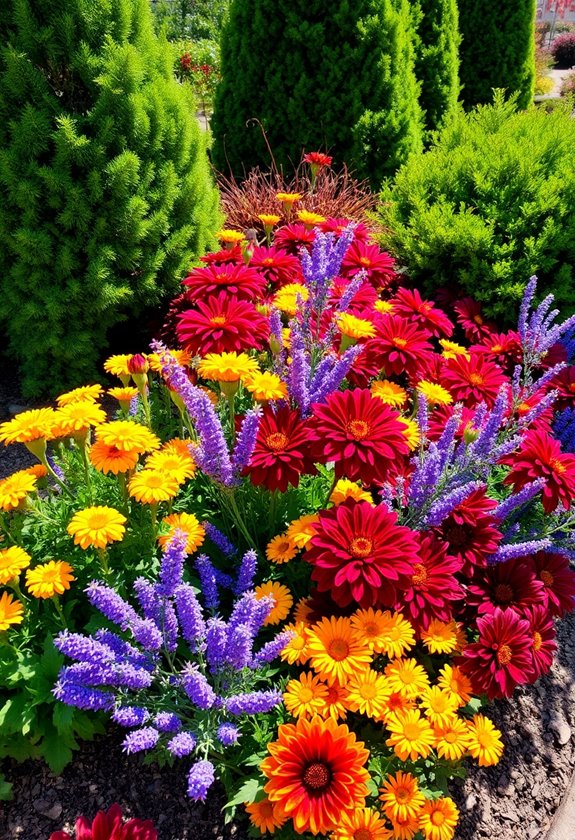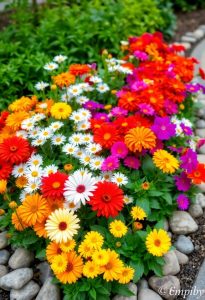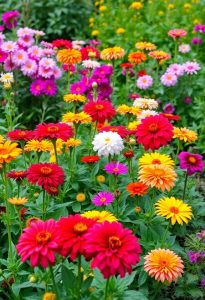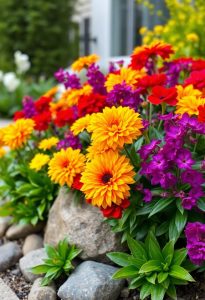Designing flower beds for all seasons can truly transform your backyard! Start by choosing seasonal plants—think tulips in spring and sunflowers in summer. Layer them for depth: tall plants in the back, medium in the middle, and low in the front. Don’t forget vibrant colors—mix warm and cool tones for eye-catching combinations! Wildlife loves native flowers, too, so add some to attract pollinators. Intrigued? Keep going to discover more tips and tricks for your garden!
Important Highlights
- Plan for seasonal blooms by choosing flowers that thrive in spring, summer, fall, and winter to ensure year-round color and interest.
- Use a variety of plant heights to create depth, placing tall plants at the back, medium plants in the middle, and low plants at the front.
- Select complementary and analogous color schemes to enhance visual appeal and maintain harmony throughout the seasons.
- Incorporate native plants to attract pollinators, creating a wildlife-friendly garden that supports local ecosystems.
- Ensure proper soil quality and drainage for healthy plant growth, and group plants for better visual impact and maintenance.
Understanding Seasonal Planting
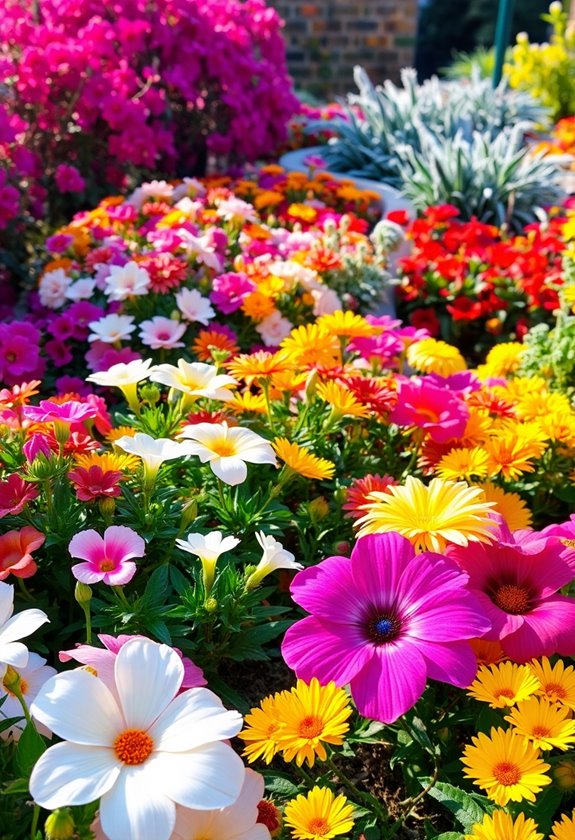
When you think about planting a flower bed, do you ever wonder why some flowers seem to bloom gloriously while others just sit there looking sad? It all boils down to understanding seasonal planting! Timing is essential. For example, spring is perfect for tulips and daffodils, while summer calls for sunflowers and zinnias. Think about your climate too—local conditions can make or break your garden’s success! To avoid disappointment, try planting in groups and using quality soil. Regular watering is crucial to enhance blooming potential. Remember, gardening’s a journey; don’t be afraid to experiment! After all, even the best gardeners have their share of “oops” moments!
Choosing the Right Plants for Year-Round Interest

Creating a garden that looks beautiful all year long is like crafting a masterpiece where every season adds its own unique brushstroke. Want year-round interest? Choose plants that bloom in different seasons! Consider these options:
- Spring: Plant tulips and daffodils for vibrant colors.
- Summer: Add sunflowers and daylilies for sunshine vibes.
- Fall: Incorporate asters and ornamental grasses for rich hues.
- Winter: Don’t forget evergreens or winterberry for structure.
Mixing textures and shapes keeps it exciting! Think about your space and climate, too. Climate compatibility is crucial when selecting the right plants for your garden. What plants spark joy for you? Remember, a little planning goes a long way in creating your seasonal showstopper!
Designing With Color Schemes
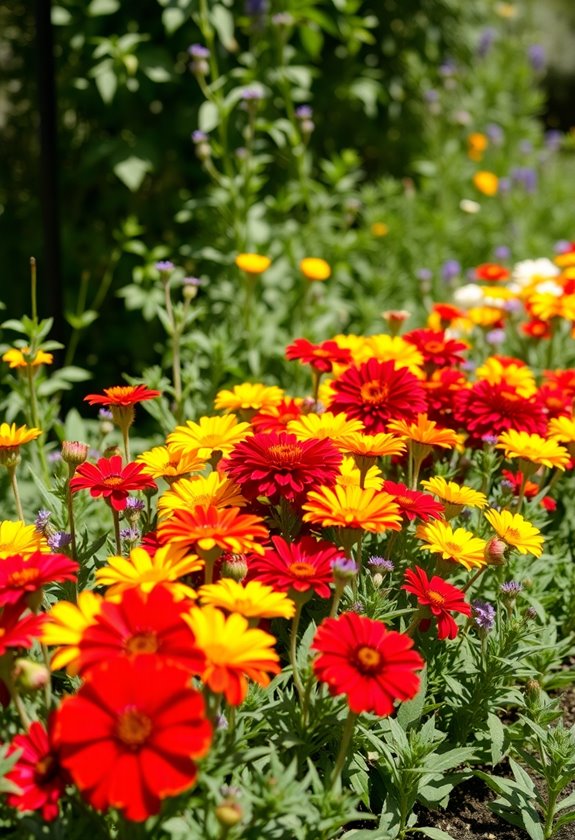
Color schemes can truly transform your flower beds, making them pop in ways that will take your breath away! Imagine planting vibrant reds next to calming blues; it creates an eye-catching contrast. Consider these tips:
- Complementary Colors: Use colors opposite each other on the color wheel, like yellow and purple.
- Analogous Colors: Stick to colors next to each other, such as oranges and reds, for a harmonious look.
Don’t forget about the seasons! Mixing warm and cool tones keeps your garden lively year-round. Incorporating diverse plants ensures that your flower beds maintain visual interest across different seasons. What’s your favorite color combo? Let your passion shine in your designs, and have fun experimenting!
Layering for Depth and Texture
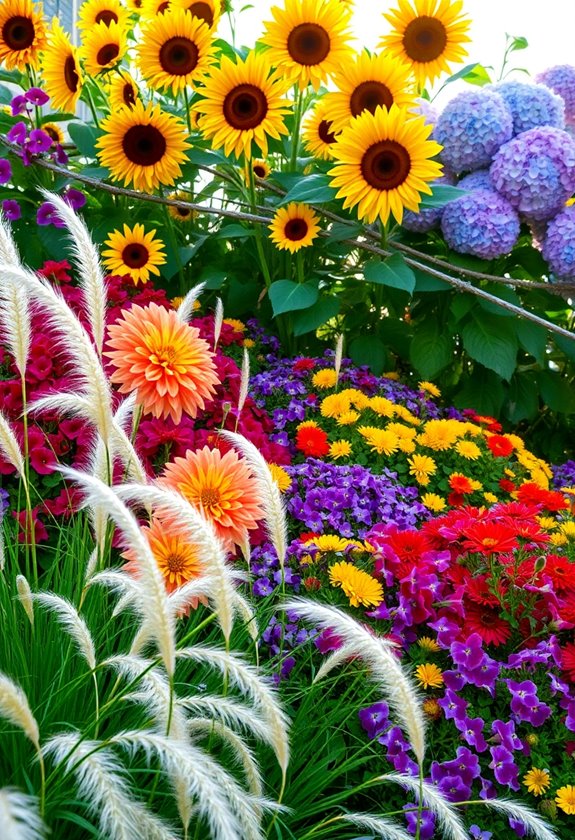
Flower beds can be more than just a pretty display; they can tell a story through layers of plants, creating depth and texture that’ll make your garden truly stand out. By layering, you add interest and invite exploration in your garden. Here’s how to do it safely and creatively:
- Tall plants: Place them at the back or center, like sunflowers or delphiniums.
- Medium plants: Use these in the middle, such as coneflowers or asters.
- Low plants: Position these at the front, like marigolds or creeping thyme.
Incorporating proper drainage systems is essential to prevent waterlogging and root rot, ensuring that your layered flower beds thrive. Have fun experimenting with different combinations, and watch your garden come alive!
Incorporating Focal Points
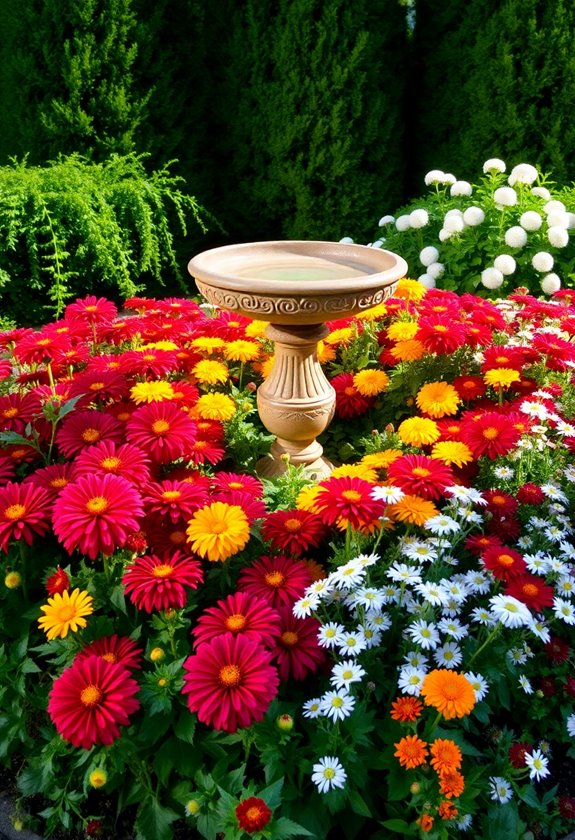
Every great garden needs a standout feature to draw the eye and spark curiosity. Focal points can transform your flower bed into a visual masterpiece! Consider adding:
- A vibrant birdbath that attracts feathered friends
- A striking sculpture that adds personality
- A colorful trellis adorned with climbing vines
These elements create interest and invite exploration. When I added a rustic bench, it became the perfect spot for quiet reflection. Remember, safety first! Verify your focal points are sturdy and securely placed. Additionally, whimsical ornaments can enhance your garden’s visual appeal and create a fun atmosphere for visitors. So, what will yours be? Let your creativity bloom, and watch your garden come alive with charm and warmth!
Planning for Maintenance and Care
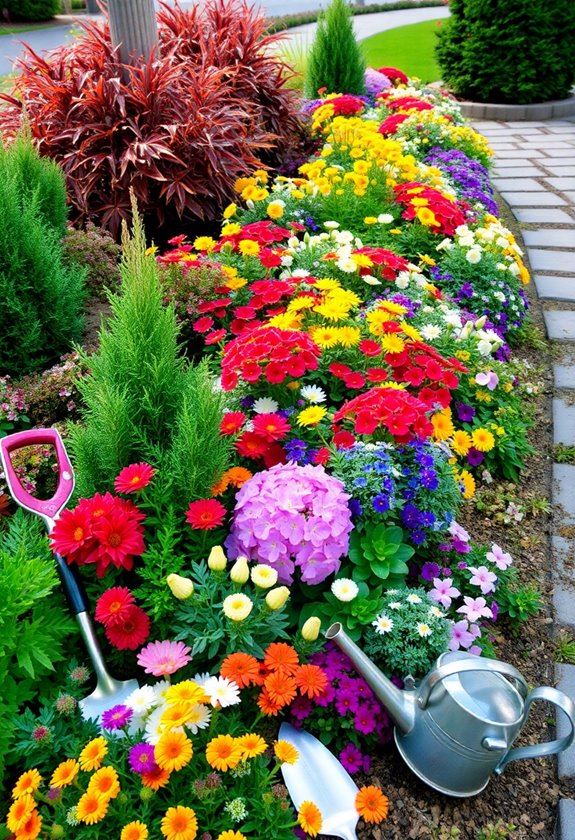
When you immerse yourself in gardening, it’s easy to get swept away by the beauty of your creations, but have you thought about how to keep that beauty thriving over time? Planning for maintenance is key! Here are some tips to keep your flower beds looking fabulous:
- Water regularly, especially during dry spells.
- Prune and deadhead to encourage new blooms.
- Mulch to retain moisture and minimize weeds!
Seasonal Plant Rotations
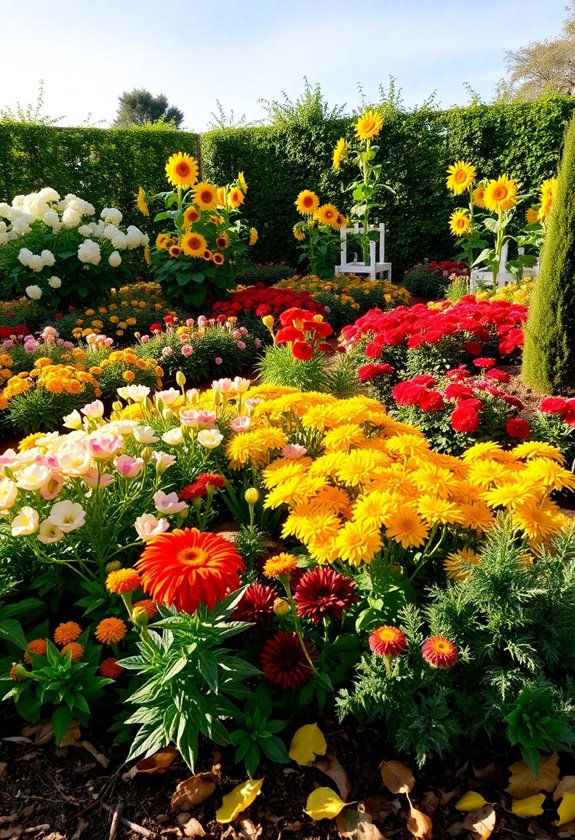
While it might seem intimidating to think about changing up your flower beds with the seasons, seasonal plant rotations can actually rejuvenate your garden and keep it thriving year-round! By swapping out plants, you can enjoy vibrant blooms throughout the year. Want to know which flowers to plant? Check out this handy table:
| Season | Plant Type | Example Flower |
|---|---|---|
| Spring | Annuals | Pansies |
| Summer | Perennials | Coneflowers |
| Fall | Bulbs | Daffodils |
Don’t forget, that keeping your garden safe means choosing disease-resistant varieties. Happy planting!
Creating a Wildlife-Friendly Garden
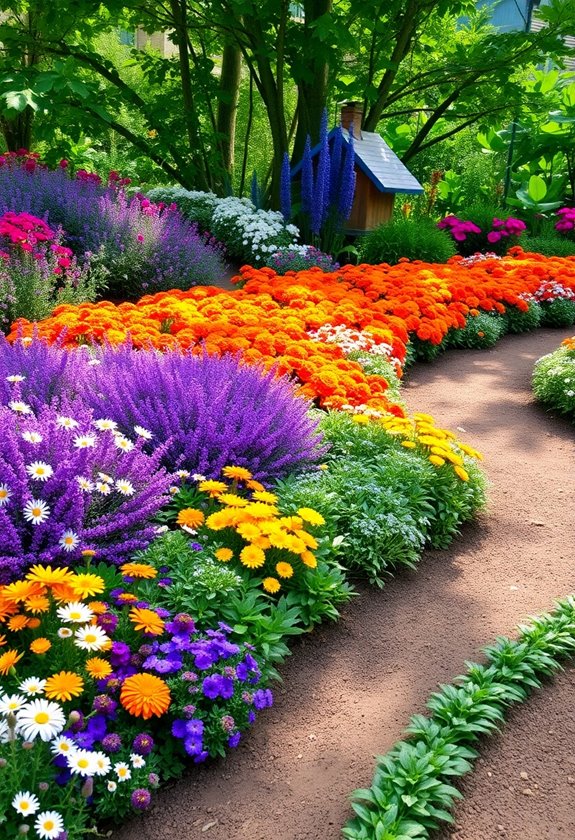
Creating a wildlife-friendly garden isn’t just about planting pretty flowers; it’s about inviting a whole world of creatures into your backyard! You’ll be amazed at how easy it is to make your space a haven for birds, butterflies, and beneficial insects. Here’s how you can get started:
- Plant native flowers that attract local pollinators.
- Provide safe water sources like shallow dishes.
- Create shelter with brush piles or native shrubs.
These simple steps not only enhance your garden’s beauty but also create a thriving ecosystem. So, are you ready to welcome nature into your backyard? Let the adventure begin!
Frequently Asked Questions
What Are the Best Tools for Designing Flower Beds?
They say, “A good tool is worth its weight in gold!” When designing flower beds, you’ll want a few essentials. Grab a trowel for digging, pruners for shaping, and a measuring tape to keep your layout neat. Don’t forget gardening gloves to protect your hands! A sturdy wheelbarrow makes transporting soil a breeze, too. With these tools in hand, you’re ready to create a beautiful garden that’ll be the envy of your neighbors!
How Can I Effectively Budget for Flower Bed Design?
Budgeting for flower bed design can be fun! Start by listing what you need—plants, soil, tools, and maybe some cute decorations. Set a limit for each item, and don’t forget to check for sales—who doesn’t love a good deal? You could even consider starting small and expanding later. Have you thought about swapping plants with friends? It’s a great way to save money and make your garden unique! Happy planning!
What Common Mistakes Should I Avoid When Designing Flower Beds?
Did you know that about 70% of amateur gardeners make common design mistakes? To avoid these pitfalls, don’t overcrowd your flower beds; plants need room to breathe and thrive! Also, consider the sun and shade each plant requires. You wouldn’t want a sun-loving flower stuck in the dark, right? Finally, don’t forget to plan for seasonal changes—mixing perennials and annuals can keep your garden blooming year-round. Happy gardening!
How Do I Choose the Right Soil for My Flower Beds?
Choosing the right soil for your flower beds is essential! You’ll want a mix that drains well but retains moisture, like loamy soil. Here are some tips:
- Test your soil: A simple kit can help you know its pH and nutrients.
- Add organic matter: Compost boosts fertility and structure.
- Consider your flowers: Some love sandy soil, while others thrive in clay.
Isn’t it exciting to think about how your flowers will flourish? Happy gardening!
Can I Design Flower Beds in Small Spaces?
Absolutely, you can design flower beds in small spaces! It’s like creating a cozy nook in your garden. Think about vertical gardening or using containers; these methods let you maximize your space beautifully. You could try planting compact flowers or herbs that won’t take over. Isn’t it exciting to imagine your little oasis? Just remember, even in tight spots, creativity can flourish! So, roll up your sleeves and let your imagination bloom!

